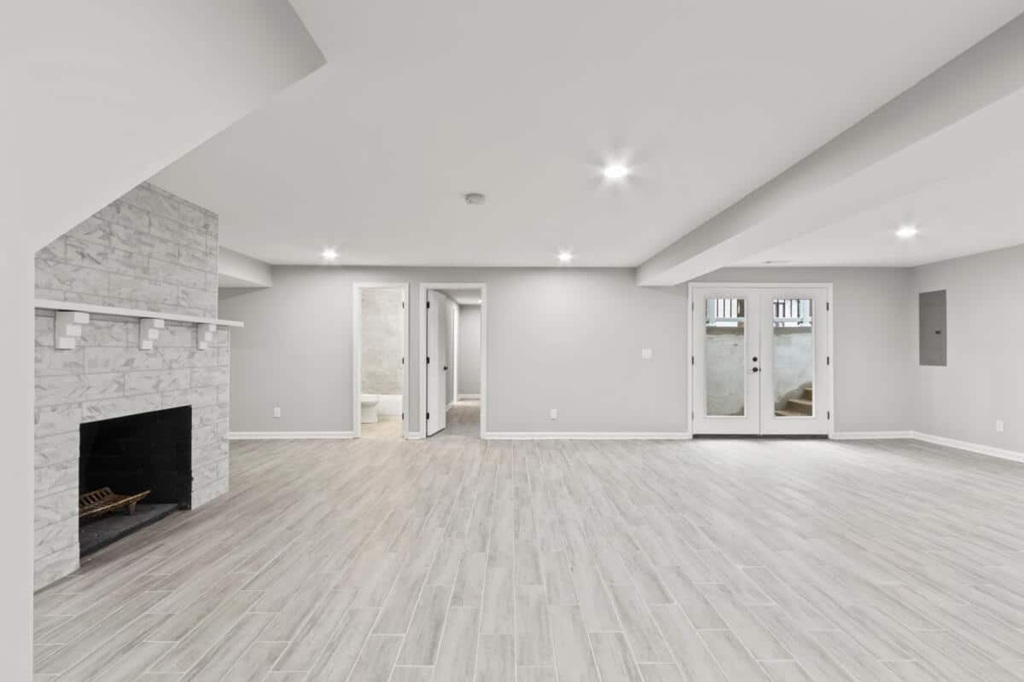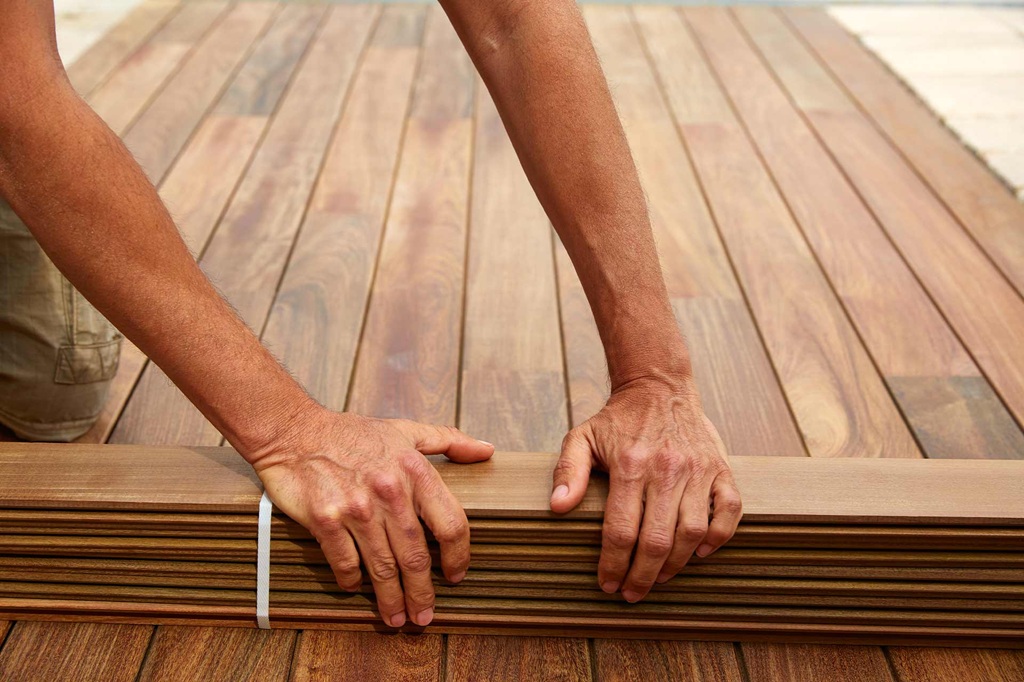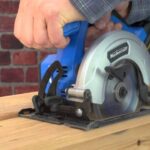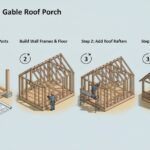
Transforming your basement from a dark, forgotten space into a functional and inviting extension of your home doesn’t have to drain your bank account. The key lies in smart flooring choices. Basements present unique challenges – moisture, potential for uneven subfloors, and varying temperatures – all of which need to be considered when selecting materials. However, with a little creativity and knowledge, you can achieve a stylish and durable basement floor without breaking the bank.
This comprehensive guide explores 10 inexpensive basement flooring options that not only fit a tight budget but also boast impressive aesthetics, durability, and often, DIY-friendly installation. We’ll delve into the pros and cons of each, helping you make an informed decision for your unique basement space.
-
Painted Concrete: The Ultimate Budget Transformation
Average Cost: $0.50 – $2 per square foot (materials only)
Your basement’s existing concrete slab is the most inexpensive starting point. Painting it can dramatically transform the space from drab to fab. This option is incredibly versatile, allowing for a multitude of colors, patterns, and even faux finishes to mimic more expensive materials like tile or stone.
Why it’s great for basements:
- Extremely Budget-Friendly: Often the cheapest option as you’re utilizing the existing structure.
- Water-Resistant: A good quality concrete floor paint or sealer provides a protective, moisture-resistant barrier.
- Durable: Concrete is inherently tough and can withstand heavy foot traffic.
- DIY-Friendly: With proper preparation and the right paint, this is a manageable DIY project.
- Customizable: Stencils, multiple colors, and even acid stains can create unique looks.
Things to consider:
- Preparation is key: The concrete must be thoroughly cleaned, degreased, and etched for proper paint adhesion. Any cracks or imperfections need to be repaired.
- Can be cold: Concrete can feel cold underfoot. Consider area rugs for warmth and comfort.
- Hard surface: While durable, it’s not the most forgiving surface for spills or falls.
-
Epoxy Coatings: Industrial Chic Meets Durability
Average Cost: $2 – $7 per square foot (materials only)
Epoxy coatings offer a seamless, high-gloss, and incredibly durable finish for concrete floors. Often seen in garages and commercial spaces, epoxy is gaining popularity in basements for its modern aesthetic and exceptional performance. It creates a waterproof barrier and is highly resistant to stains, chemicals, and abrasions.
Why it’s great for basements:
- Exceptional Durability: Stands up to heavy use, impacts, and spills.
- Waterproof: Forms a non-porous, moisture-proof surface, ideal for basements.
- Easy to Clean: Spills wipe up effortlessly.
- Modern Aesthetic: Available in various colors, and can be enhanced with decorative flakes or metallic pigments for a stunning, custom look.
- Good for high-traffic areas: Perfect for workshops, home gyms, or playrooms.
Things to consider:
- Surface preparation is critical: The concrete must be perfectly clean, dry, and free of any contaminants. Grinding may be required for optimal adhesion.
- Fumes during application: Proper ventilation is essential during installation.
- Can be slippery: Consider adding anti-slip additives, especially in areas prone to moisture.
- Can be a more involved DIY: While possible, it requires careful attention to detail and mixing ratios.
-
Vinyl Flooring (Sheet, Tile, and Plank): Versatility on a Budget
Vinyl flooring has come a long way from its reputation as a drab, utilitarian option. Modern vinyl offers incredible versatility in terms of style, mimicking everything from hardwood to natural stone, at a fraction of the cost. It comes in three main forms: sheet vinyl, vinyl tiles (including peel-and-stick), and luxury vinyl planks (LVP) or tiles (LVT).
3a. Sheet Vinyl:
Average Cost: $0.50 – $2 per square foot
Sheet vinyl is the most budget-friendly of the vinyl options. It comes in large rolls, minimizing seams and offering excellent water resistance.
Why it’s great for basements:
- Very Affordable: One of the lowest-cost flooring options.
- Highly Water-Resistant: Few seams mean fewer places for moisture to penetrate.
- Easy to Clean: Smooth surface makes cleaning a breeze.
- Good for larger areas: Less installation time due to fewer seams.
Things to consider:
- Subfloor imperfections show: Any bumps or divots in the concrete will likely be visible through the sheet vinyl.
- More challenging DIY for large areas: Requires precise cutting and careful handling of large, heavy rolls.
- Repair can be difficult: If damaged, repairing a section can be tricky; often, the entire sheet needs replacement.
3b. Peel-and-Stick Vinyl Tiles:
Average Cost: $1 – $3 per square foot
These self-adhesive tiles are a DIY dream, making them incredibly popular for quick and inexpensive updates.
Why it’s great for basements:
- Extremely DIY-Friendly: Simple peel-and-stick installation.
- Affordable: Low material cost.
- Easy to Replace: If a tile gets damaged, you can simply remove and replace it.
- Variety of styles: Available in various patterns and colors.
Things to consider:
- Adhesive can fail in high moisture: While the tiles themselves are water-resistant, the adhesive can be compromised by excessive moisture, leading to curling or lifting. A sealant on the concrete subfloor is highly recommended.
- Less durable than other vinyl types: Can be prone to dents and scratches over time, especially with heavy traffic.
- Subfloor prep is still important: A clean, level surface is crucial for good adhesion.
3c. Luxury Vinyl Plank (LVP) & Luxury Vinyl Tile (LVT):
Average Cost: $2 – $7 per square foot
LVP and LVT are engineered to convincingly replicate the look and feel of natural wood or stone. They are thicker, more durable, and often feature click-lock installation systems. Many LVP/LVT options are now 100% waterproof.
Why it’s great for basements:
- Highly Water-Resistant/Waterproof: Many options are designed to be fully waterproof, making them ideal for basements.
- Excellent Aesthetics: Realistic wood grain textures and stone patterns.
- Durable: Resists scratches, dents, and scuffs better than traditional vinyl.
- Relatively Easy to Install: Many feature DIY-friendly click-lock systems.
- Comfortable underfoot: Often has a softer feel than concrete or tile.
Things to consider:
- Higher cost than other vinyl: Still budget-friendly, but more expensive than sheet or peel-and-stick.
- Subfloor must be level: Imperfections can still affect the look and performance.
- Quality varies: Invest in a good quality product for better performance and longevity.
-
Carpet Tiles: Warmth and Flexibility
Average Cost: $1.50 – $4 per square foot
Carpet tiles offer a cozy and comfortable solution for basements, especially if you envision it as a living area, playroom, or home theater. Unlike traditional wall-to-wall carpeting, individual tiles allow for easy replacement if one gets damaged or stained.
Why it’s great for basements:
- Comfortable and Warm: Provides insulation and a soft surface underfoot.
- Sound Absorption: Helps to reduce echoes and noise, making the basement feel more inviting.
- DIY-Friendly: Many are peel-and-stick, or can be installed with releasable adhesive tabs.
- Easy to Replace: Damaged tiles can be swapped out without replacing the entire floor.
- Hides imperfections: Can mask minor irregularities in the concrete subfloor.
Things to consider:
- Moisture Sensitivity: While tiles can be removed to dry, traditional carpet is generally not recommended for basements with significant moisture issues. Look for moisture-resistant options.
- Stains: Lighter colors can show stains more easily.
- Can trap allergens: Regular vacuuming is essential.
- Low-pile recommended: Less prone to trapping moisture and easier to clean.
-
Laminate Flooring: The Look of Wood Without the Price Tag
Average Cost: $2 – $6 per square foot
Laminate flooring provides the appealing aesthetic of hardwood or stone at a fraction of the cost. It’s constructed with a photographic layer topped by a durable wear layer, making it resistant to scratches and fading. Modern advancements have also introduced water-resistant and even waterproof laminate options, making them more suitable for basement environments.
Why it’s great for basements:
- Affordable Hardwood/Stone Look: Offers a high-end appearance without the premium price.
- Durable Wear Layer: Resists scratches and everyday wear.
- DIY-Friendly Installation: Many feature click-lock systems for easy floating installation.
- Variety of Styles: Extensive range of wood species, stone patterns, and colors.
- Newer water-resistant options: Improved moisture performance for basements.
Things to consider:
- Traditional laminate is not waterproof: Moisture can cause swelling and warping. Crucially, only choose water-resistant or waterproof laminate for basements.
- Can be noisy: May produce a hollow sound when walked on. An underlayment can help.
- Cannot be refinished: Unlike real hardwood, laminate cannot be sanded and refinished.
-
Ceramic or Porcelain Tile: Durable and Moisture-Proof
Average Cost: $2 – $8 per square foot (materials only)
Ceramic and porcelain tiles are classic choices for basements due to their inherent durability and resistance to moisture. They offer a vast array of designs, colors, and textures, from sleek modern looks to rustic stone imitations.
Why it’s great for basements:
- Excellent Water Resistance/Waterproof: Impervious to water, making them ideal for moisture-prone basements.
- Highly Durable: Extremely long-lasting and resistant to wear and tear.
- Easy to Clean: Wipes clean easily and resists stains.
- Versatile Design: Countless options to match any aesthetic.
Things to consider:
- Installation can be costly: While materials can be inexpensive, professional installation can add significantly to the overall cost. DIY tiling requires patience and skill.
- Can be cold and hard: Similar to concrete, tile can feel cold and unforgiving underfoot.
- Grout lines require maintenance: Grout can stain and may need periodic sealing.
- Subfloor prep is essential: A perfectly level and stable subfloor is crucial to prevent cracking.
-
Rubber Flooring: Functional and Fun
Average Cost: $2 – $8 per square foot
Often found in gyms and playrooms, rubber flooring is an increasingly popular and practical choice for basements. It’s incredibly durable, comfortable, and offers excellent shock absorption.
Why it’s great for basements:
- Highly Durable: Built to withstand heavy impact and traffic.
- Waterproof/Water-Resistant: Resists moisture, making it suitable for basements.
- Comfortable and Resilient: Provides a soft, cushioned surface, ideal for active spaces.
- Sound Dampening: Absorbs sound, reducing noise levels.
- Slip-Resistant: Naturally provides good traction.
- Easy to Clean: Wipes down easily.
Things to consider:
- Odor: Some rubber flooring can have a noticeable odor, especially when new.
- Aesthetics: While improving, the range of stylish options is still narrower than other materials.
- Cost can add up for thicker options: Thicker rolls or interlocking tiles are more expensive.
Related: Transform Your Space on a Budget: Five Cheap Flooring Upgrades
-
Engineered Wood Flooring: Real Wood, Basement-Friendly

Average Cost: $4 – $9 per square foot
If you truly crave the warmth and timeless appeal of wood, engineered wood flooring is a more basement-friendly alternative to solid hardwood. It features a thin veneer of real wood on top of a plywood or HDF core, making it more stable and resistant to moisture fluctuations than solid wood.
Why it’s great for basements:
- Authentic Wood Look: Provides the natural beauty and warmth of real wood.
- More Moisture Resistant than Solid Wood: The layered construction offers greater stability in fluctuating humidity.
- Can be Refinished (limited): Some thicker veneers can be sanded and refinished once or twice.
- Click-lock installation: Many options are designed for DIY floating installation.
Things to consider:
- Still sensitive to excessive moisture: While improved, engineered wood is not waterproof and should not be used in basements prone to flooding or significant dampness.
- Higher cost: Generally more expensive than laminate or vinyl.
- Requires proper subfloor preparation: A vapor barrier is essential.
-
Stained or Polished Concrete: Industrial Elegance
Average Cost: Stained: $1 – $5 per square foot | Polished: $3 – $15+ per square foot
Beyond just painting, your existing concrete floor can be transformed into a work of art through staining or polishing. Staining creates translucent, variegated colors that penetrate the concrete, offering a unique and organic look. Polishing involves grinding and sealing the concrete to a high sheen, revealing the aggregate within for a sophisticated, industrial aesthetic.
Why it’s great for basements:
- Extremely Durable: Concrete is built to last.
- Low Maintenance: Easy to clean and resists stains.
- Unique Aesthetics: Creates a high-end, custom look.
- Moisture-Resistant: Inherently resistant to water damage (though a sealer is still recommended).
- Sustainable: Utilizes an existing material, reducing waste.
Things to consider:
- Preparation is crucial: The concrete must be clean, repaired, and free of coatings for proper stain penetration or polishing.
- Can be cold and hard: Similar to painted concrete.
- Professional help often recommended: Achieving a truly professional polished or stained finish often requires specialized equipment and expertise, which can increase costs. DIY staining is possible but requires careful technique.
- Subfloor imperfections may show: Staining and polishing highlight the natural character of the concrete, including any existing cracks or imperfections.
Related: Five Popular Flooring Trends
-
Plywood Plank Floors: Rustic Charm on a Dime
Average Cost: $1 – $3 per square foot (materials only)
For the adventurous DIYer seeking a truly unique and rustic look, plywood planks can be a surprisingly effective and inexpensive basement flooring option. Standard plywood sheets are cut into planks, installed, and then stained or painted to create a customized floor.
Why it’s great for basements:
- Extremely Budget-Friendly: Plywood is a relatively cheap material.
- Highly Customizable: Endless possibilities for stains, paints, patterns, and distressed finishes.
- DIY-Friendly (with tools): Requires basic woodworking skills and tools for cutting and installation.
- Rustic Aesthetic: Creates a warm, industrial, or farmhouse-inspired look.
Things to consider:
- Moisture Sensitivity: Plywood is wood, and thus vulnerable to moisture. A robust vapor barrier beneath and proper sealing/finishing on top are absolutely essential in basements.
- Requires significant prep: Cutting, sanding, sealing, and finishing can be time-consuming.
- Not ideal for very damp basements: Even with careful sealing, it’s best suited for basements with minimal moisture issues.
- Can be prone to splintering: Proper sanding and finishing are crucial.
Related: Choosing Flooring for your Conservatory
Choosing Your Ideal Basement Floor: Key Considerations
Before making your final decision, ask yourself these crucial questions:
- Moisture Levels: Is your basement prone to dampness, occasional leaks, or even flooding? This is the most critical factor. Opt for waterproof or highly water-resistant options like vinyl, tile, or epoxy if moisture is a concern.
- Subfloor Condition: Is your concrete slab level and smooth? Or does it have cracks, dips, or bumps? Some flooring options are more forgiving of imperfections than others.
- Intended Use of the Space: Will it be a high-traffic playroom, a quiet guest bedroom, a home gym, or a utility area? The function of the room will influence durability and comfort needs.
- DIY vs. Professional Installation: Are you comfortable tackling the installation yourself, or will you need to factor in professional labor costs? Many of the options above are DIY-friendly, saving you money.
- Aesthetics: What kind of look and feel are you aiming for? Modern, rustic, cozy, industrial?
- Comfort and Warmth: How important is a soft, warm surface underfoot?
- Long-Term Durability: How long do you want the floor to last, and how much wear and tear will it endure?
By carefully evaluating these factors and exploring the 10 inexpensive yet stylish options presented, you can confidently choose the perfect basement flooring that not only looks fantastic but also respects your budget. Your dream basement is within reach!




